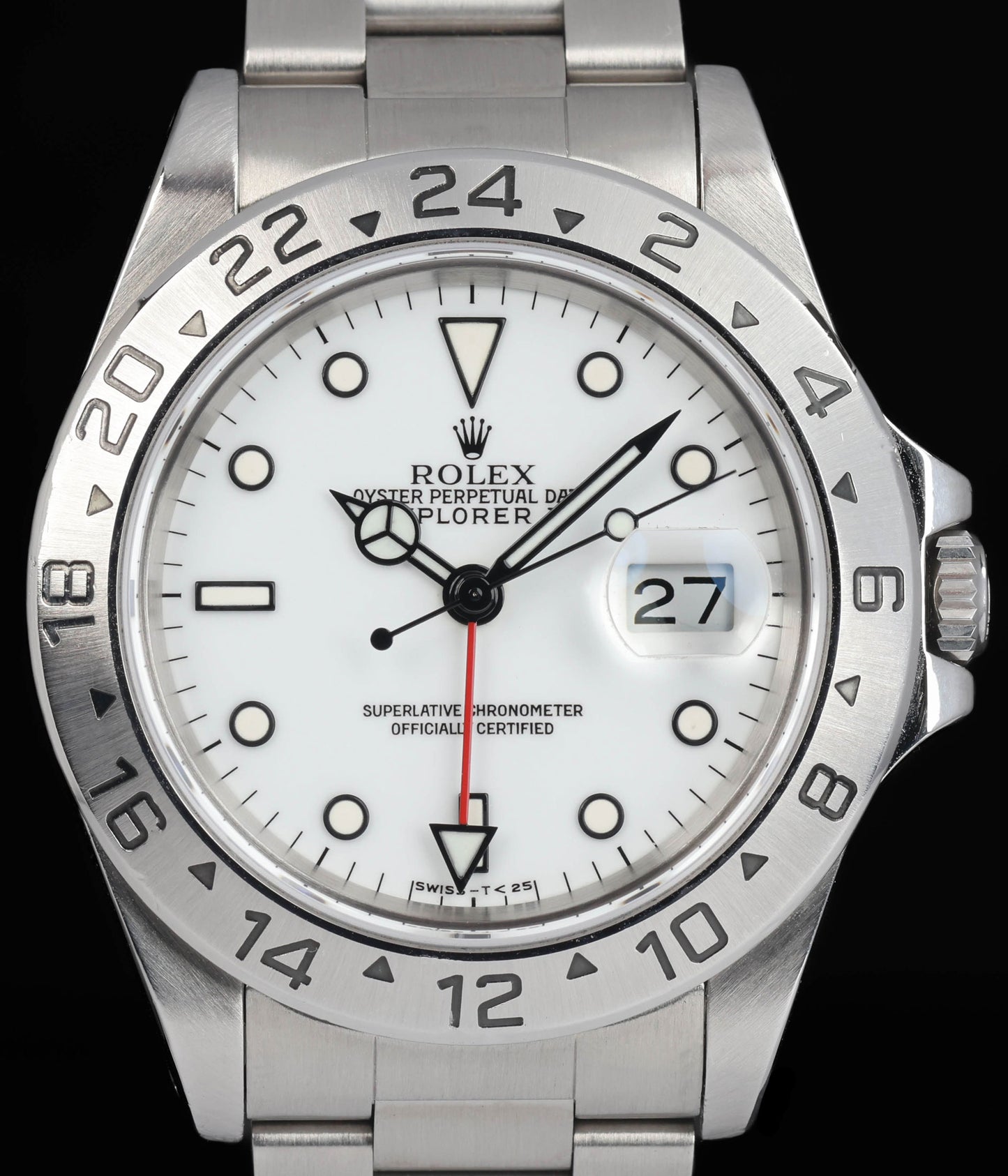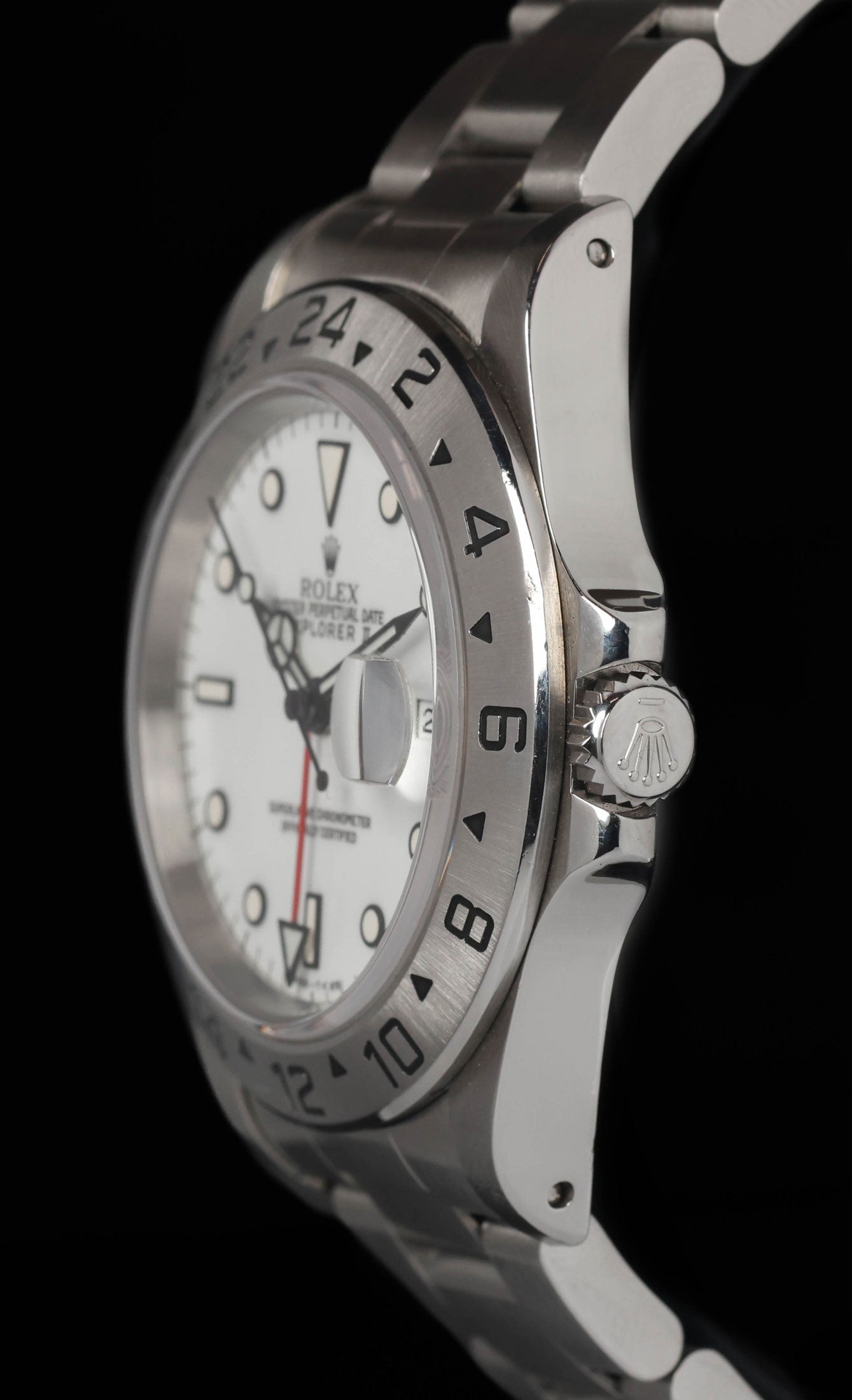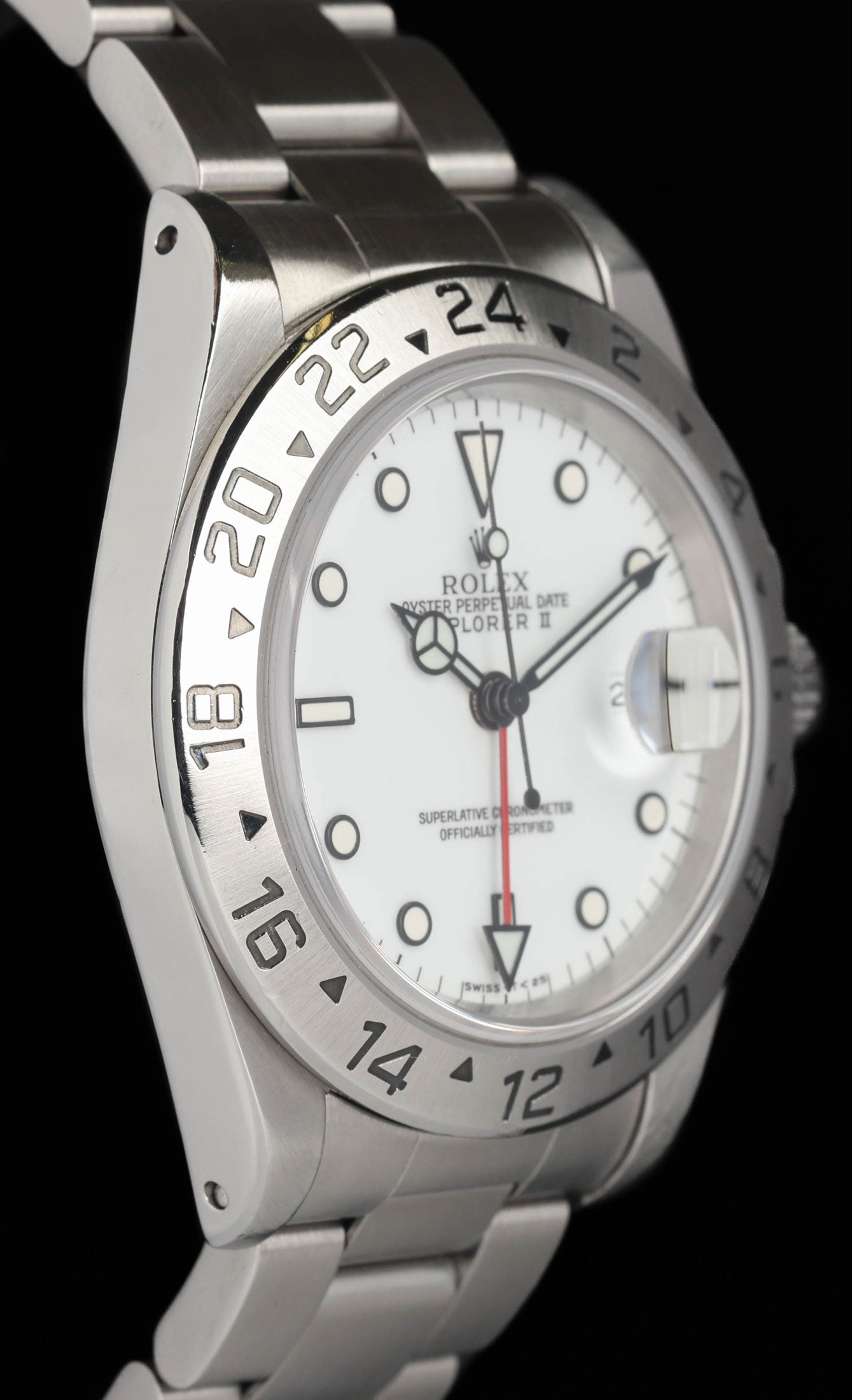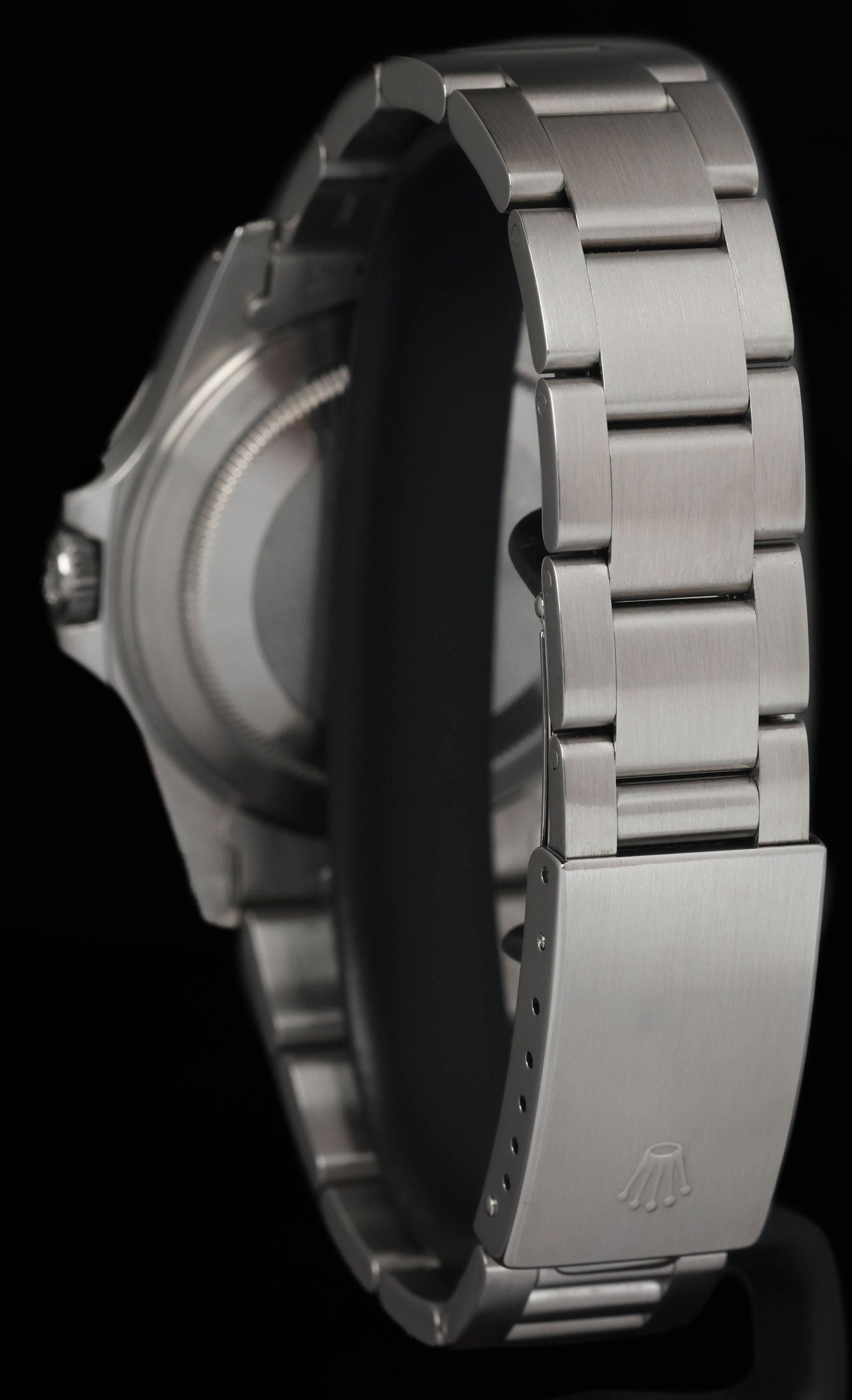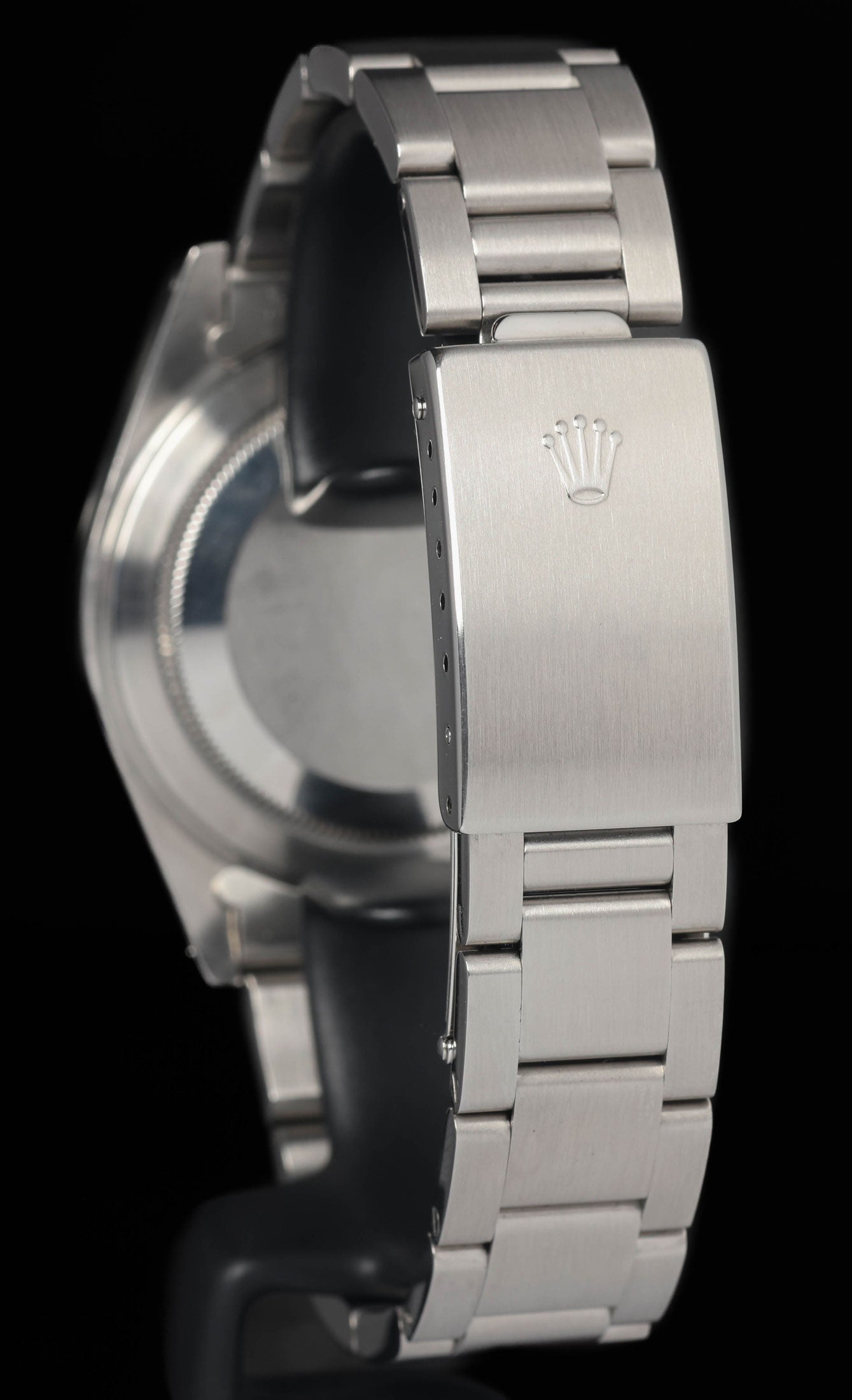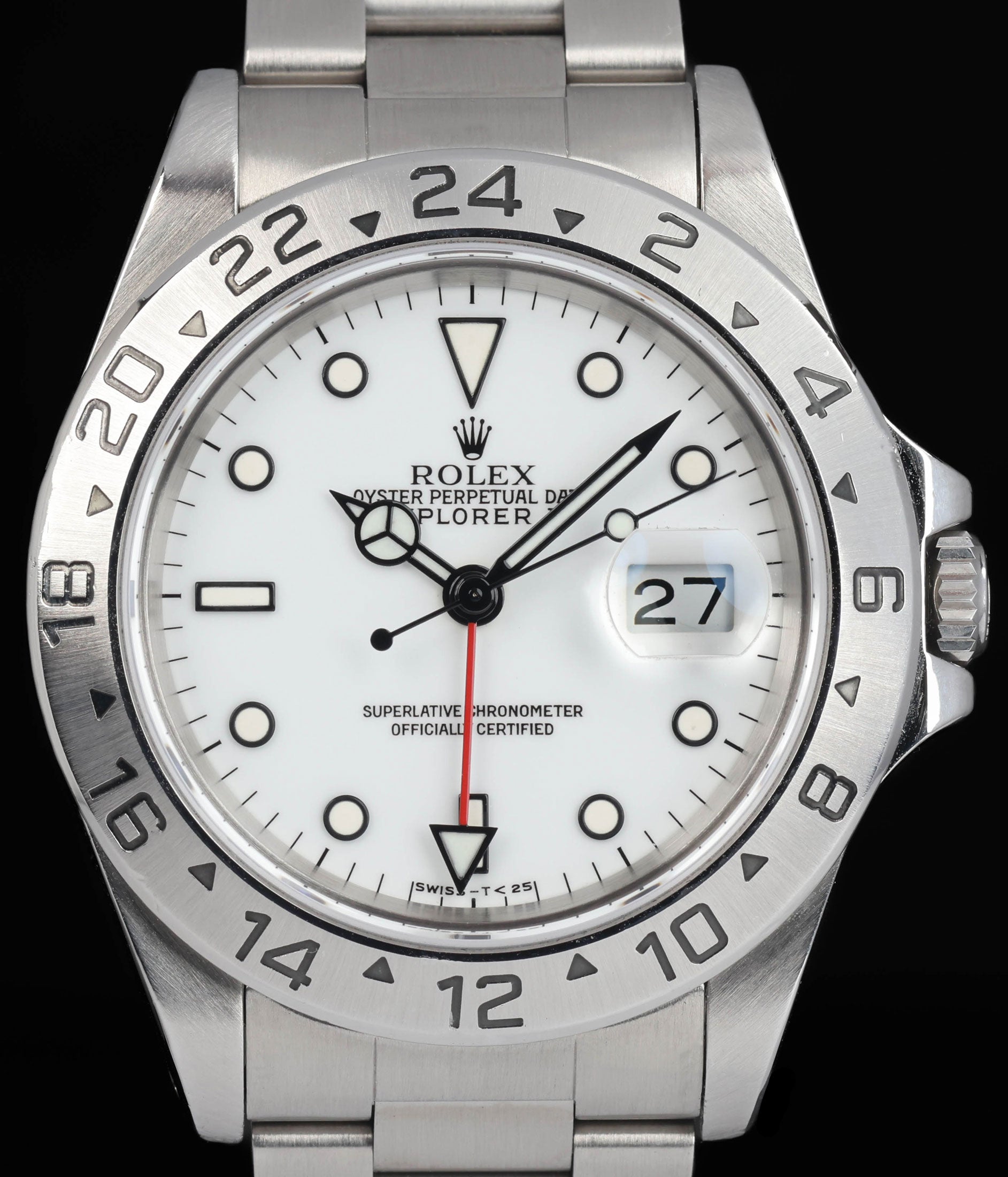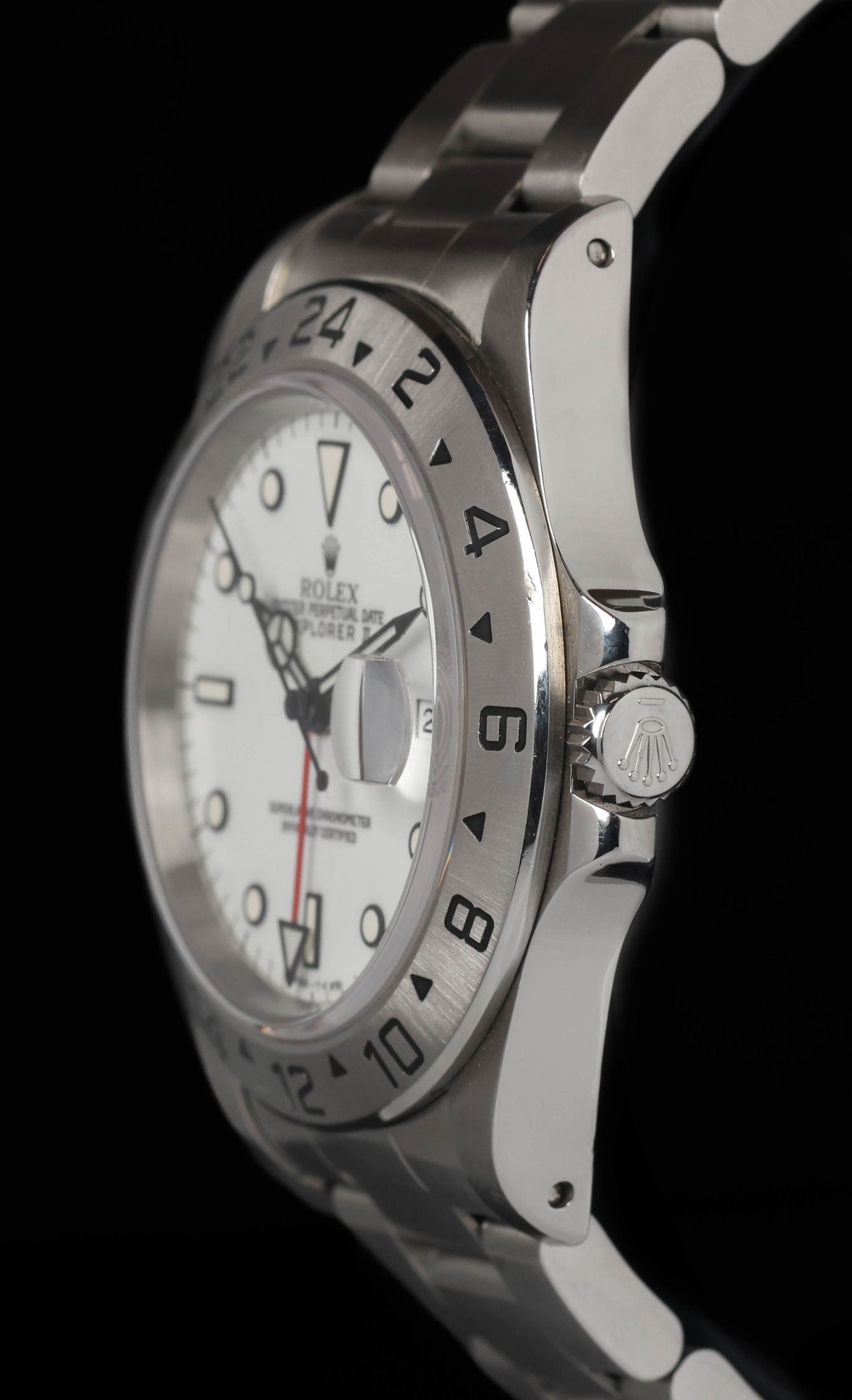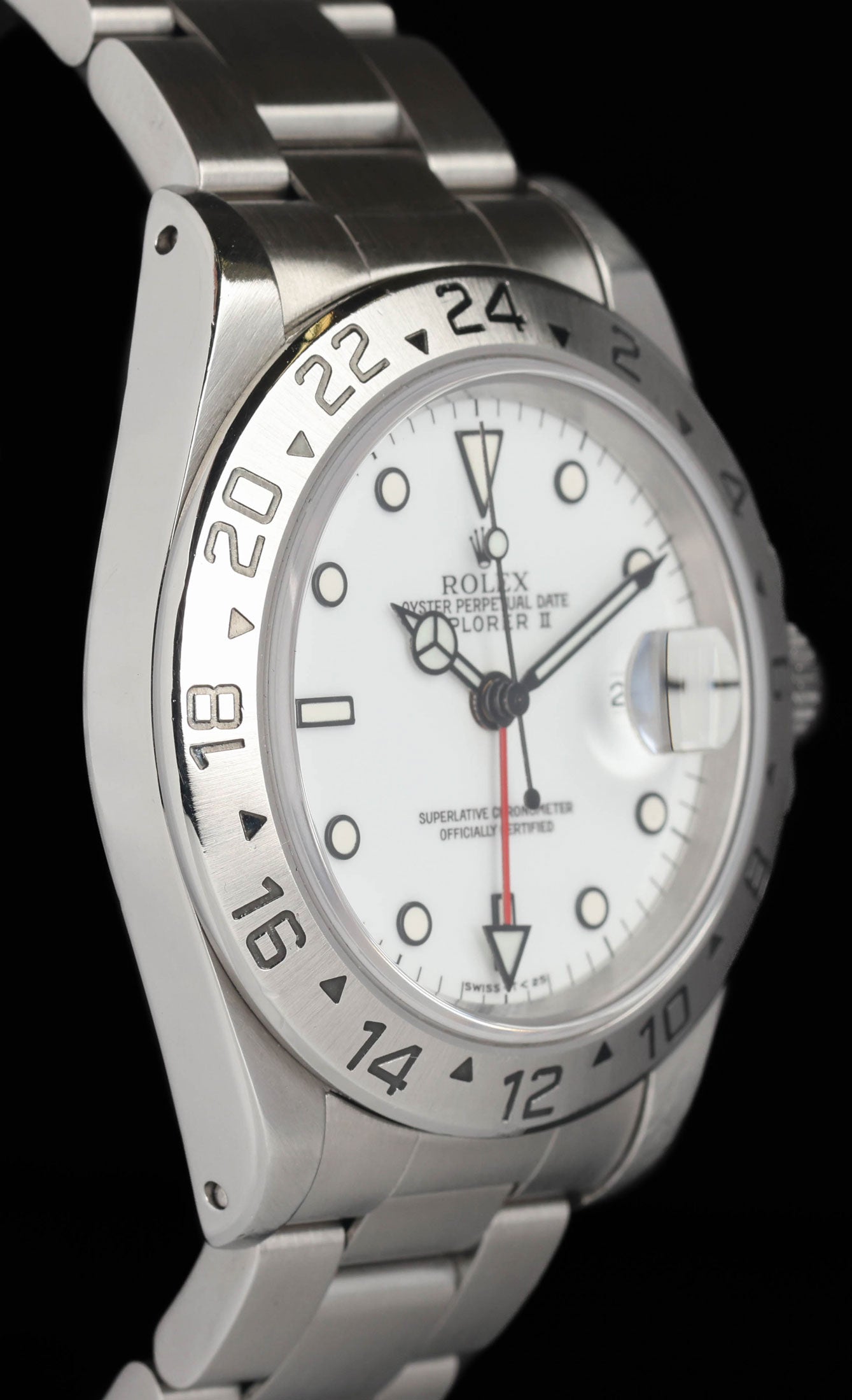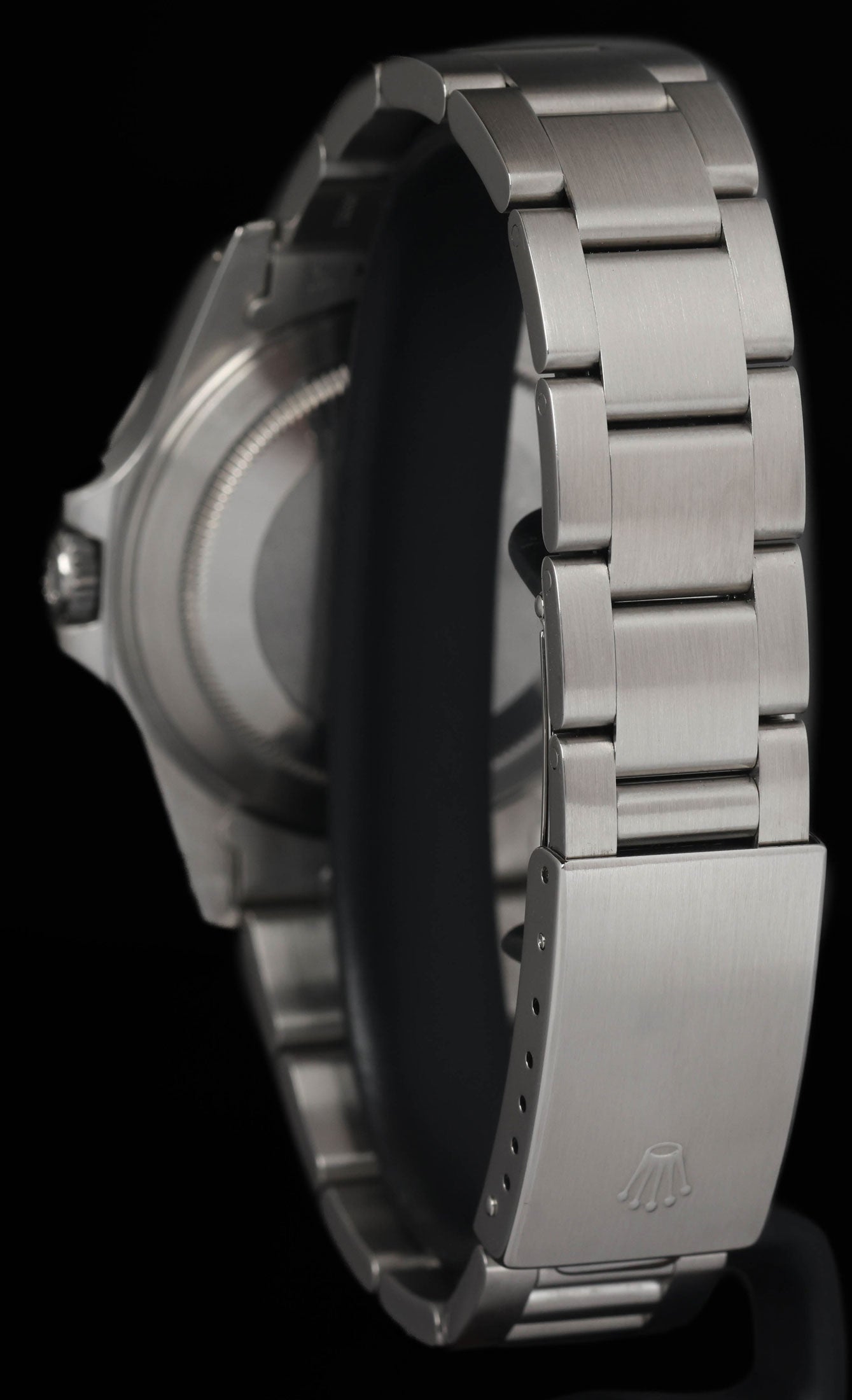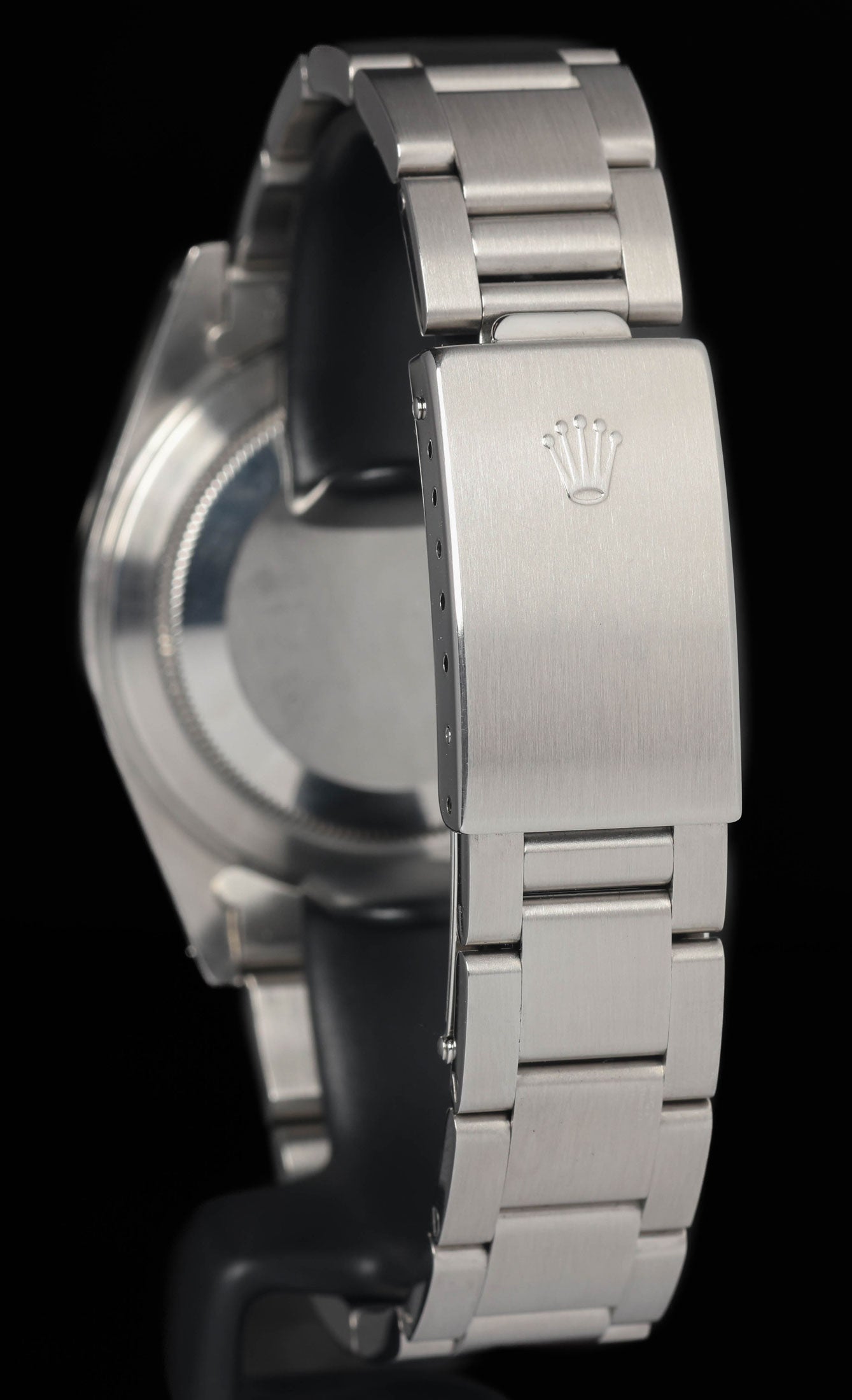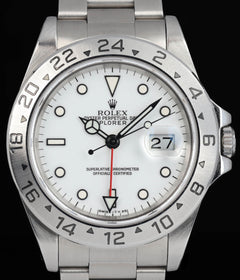Crown Vintage
Rolex Explorer II 16570 'Polar' 40mm 1995
Rolex Explorer II 16570 'Polar' 40mm 1995
Couldn't load pickup availability
Rolex Explorer II 16570 'Polar' 40mm 1995
The case of this Rolex Explorer II 16570 ‘Polar’ remains in great condition, with light hairlines visible under close inspection and sharp lugs that retain their original profile. The fixed 24-hour bezel shows a small pinhead chip at the 2 o’clock position, though this does not detract from its overall presentation. The Oyster bracelet is in very good condition, showing light hairlines from wear but little to no stretch. The white ‘Polar’ dial is in excellent condition, with crisp black surrounds on the hour markers and hands, offering striking contrast and legibility. The hands are also in excellent condition, with luminous material intact and free of flaws. This well-preserved example reflects the robustness and enduring appeal of the 16570 reference.
Share
Why we love this watch
Why we love this watch
The Rolex Explorer II 16570: The Evolution of a Purpose-Built Tool Watch
Introduction
The Rolex Explorer II has long stood as one of the most distinctive tool watches in the Oyster line. Launched in 1971 with the reference 1655, the model was designed not for divers or pilots, but for spelunkers, polar explorers, and adventurers who required a watch capable of tracking time in extreme conditions where daylight could be scarce or absent altogether. The 16570, introduced in 1989, represented the second generation of the Explorer II and remained in production for over two decades, making it one of the most enduring references in Rolex’s catalogue.
. But beyond its aesthetics, the 16570 stands as a symbol of Rolex’s ability to refine a niche concept into a versatile, functional, and timeless sports watch.
The Origins of the Explorer II
The Explorer II owes its existence to the success of the original Explorer I, launched in 1953 in honour of the ascent of Mount Everest. Where the Explorer I was a simple three-hand time-only watch, the Explorer II, launched with the reference 1655, expanded on that concept by introducing a 24-hour hand and a fixed bezel. The purpose was simple: to help those operating in environments where day and night could be indistinguishable—underground explorers, polar researchers, or even those working in deep jungle or desert environments.
The original 1655, with its bold orange 24-hour hand and cluttered dial, was a cult classic but never achieved the widespread popularity of the Submariner or GMT-Master. However, its singularity of purpose gave it an aura of authenticity that would later enhance its reputation.
The Arrival of the 16570
By the late 1980s, Rolex sought to modernise the Explorer II while retaining its functional DNA. The 16570 replaced the outgoing 16550 and was produced from 1989 until 2011, a remarkable production run that saw it transition through several key changes in dial materials, lume, and movement technology.
The 16570 was offered in two dial variations: black and white. The white version, often called the “Polar,” is especially iconic, with its stark contrast between the dial and the bold black hour markers and hands. Many tritium-dial examples have aged beautifully, with lume plots taking on warm patina tones that soften the watch’s once-stark contrasts.
Case and Bezel Design
The 16570 retained the 40mm Oyster case that Rolex had standardised across its professional sports watches by the 1980s. Made from stainless steel, the case combined robustness with refinement, making the Explorer II versatile enough for both harsh conditions and everyday wear.
The bezel, however, remained unique to the Explorer II. Unlike the GMT-Master, whose bezel rotated to track multiple time zones, the Explorer II bezel was fixed, engraved with 24-hour numerals. The 24-hour hand was originally intended as an AM/PM indicator to help distinguish between day and night. With the arrival of the independent GMT hand in the 16550 and carried over into the 16570, however, the watch gained the ability to track a second time zone, greatly enhancing its functionality.
Dial Variations
The dial of the 16570 evolved during its long production run. Early examples were fitted with tritium lume, indicated by the “SWISS - T < 25” marking at the bottom of the dial. Over time, tritium naturally discolours, leading to creamy patina on the indices and hands, giving these watches tremendous character.
By the late 1990s, Rolex transitioned to LumiNova and later Super-LumiNova, indicated first by “SWISS” and later “SWISS MADE” at the base of the dial. These dials did not develop patina in the same way, remaining bright and white, which some prefer for their crisp appearance. The black dial version of the 16570 offered a different aesthetic, with white lume plots standing out against the glossy dial, creating a striking contrast.
The white “Polar” dial has always been the more distinctive option, with its black-framed indices and hands that ensured excellent legibility. Over time, these have become one of the most recognisable looks in the Rolex sports watch catalogue.
Movement Evolution
The 16570 saw two key movements during its production life. From its launch in 1989 until the mid-2000s, it was powered by the calibre 3185, a robust automatic movement featuring a 50-hour power reserve and an independently adjustable 24-hour hand, allowing the watch to function as a dual time zone piece. Around 2006, Rolex introduced the calibre 3186 into the 16570, offering smoother operation of the GMT hand and resistance to the “wiggle” that could occur with the 3185.
Both movements were chronometer-certified, reflecting Rolex’s commitment to precision. The 3186-equipped examples are relatively rare compared to the long production run of the 3185, making them a point of interest for those studying the model’s evolution.
The Bracelet
The 16570 was paired with the Oyster bracelet, reference 78360 in early versions and later the solid-link 78790. Early bracelets were characterised by hollow end links and a stamped clasp, which contributed to a lighter feel. Later bracelets gained solid end links (SEL) and more substantial construction, reflecting Rolex’s ongoing improvements in bracelet quality during the 2000s.
While the Jubilee bracelet was never officially offered with the Explorer II, some owners have retrofitted them for a dressier look, but the Oyster remains the most authentic pairing, reflecting the watch’s tool heritage.
Explorer II in Context
The Explorer II has always been somewhat of an outlier in the Rolex professional line-up. It lacked the rotating bezel of the GMT-Master, the depth rating of the Submariner, and the glamour of the Daytona. Instead, it remained purpose-driven, created for a narrow group of users. This, paradoxically, has become part of its charm.
During the production of the 16570, Rolex continued to refine its image as the maker of watches for those who demanded reliability in extreme conditions. The Explorer II embodied this ethos in a quieter way, never seeking the limelight but always capable of performing its intended role.
The Patina of Early Examples
Over the decades, the stark white lume has mellowed to a creamy, warm tone that contrasts beautifully with the sharp black surrounds of the indices. This transformation, unique to each watch depending on wear and storage, gives each early 16570 a distinct character.
The combination of a crisp white dial, black details, and patinated tritium is particularly attractive, softening the watch’s utilitarian aesthetic and lending it a vintage warmth that later Super-LumiNova dials lack. These early tritium “Polar” 16570s have become especially admired for this reason.
Longevity of the 16570
Produced for over 20 years, the 16570 remains one of the longest-running references in Rolex’s history. This longevity speaks to the strength of the design: Rolex found a formula that worked and saw no reason to replace it until the introduction of the larger 42mm 216570 in 2011.
The 16570’s 40mm case size, slim profile, and Oyster case proportions make it an exceptionally wearable watch even today. For many, it represents the sweet spot between vintage charm and modern usability.
Historical Significance
The Explorer II 16570 occupies an important place in the history of Rolex. It represents the brand’s commitment to creating watches for specific purposes, even when those purposes were niche. It also reflects Rolex’s incremental approach to innovation: rather than revolutionising the Explorer II, Rolex refined it over decades, improving its movement, bracelet, and lume while keeping the essential design intact.
It is also significant as one of the last Rolex sports watches to use tritium lume before the transition to LumiNova, making 1990s examples markers of a transitional period in watchmaking.
Final Thoughts
The Rolex Explorer II 16570 is a study in purposeful design and subtle evolution. Introduced in 1989 and produced until 2011, it carried the DNA of the original Explorer II while adapting to the needs of a broader audience. Its fixed 24-hour bezel, dual-time functionality, and robust Oyster case made it a practical companion for adventurers, travellers, and everyday wearers alike.
Case & Bracelet
Case & Bracelet
- Case in great condition, light hairlines visible, very sharp lugs.
- Bezel has a pin head chip at 2 o clock.
- Bracelet in very good condition, light hairlines visible. Little to no stretch.
Dial & Hands
Dial & Hands
Dial & hands excellent condition.
Warranty & Condition
Warranty & Condition
Crown Vintage Watches provides a minimum 3-month mechanical warranty on pre-owned watches, from the date of purchase.
The warranty covers mechanical defects only.
The warranty does not cover damages such as scratches, finish, crystals, glass, straps (leather, fabric or rubber damage due to wear and tear), damage resulting from wear under conditions exceeding the watch manufacturer’s water resistance limitations, and damage due to physical and or accidental abuse.
Please note, water resistance is neither tested nor guaranteed.
Shipping and insurance costs for warranty returns to us must be covered by the customer. Returns must be shipped via traceable courier. Return shipment must be pre-paid and fully insured. Collect shipping will be refused. In case of loss or damages, the customer is liable.
Our Pledge
At Crown Vintage Watches, we stand by the authenticity of every product we sell. For added peace of mind, customers are welcome to have items independently authenticated at their own expense.
Condition
Due to the nature of vintage timepieces, all watches are sold as is. We will accurately describe the current condition and working order of all watches we sell to the best of our ability.
Shipping & Refund
Shipping & Refund
